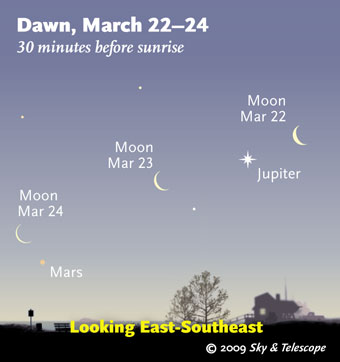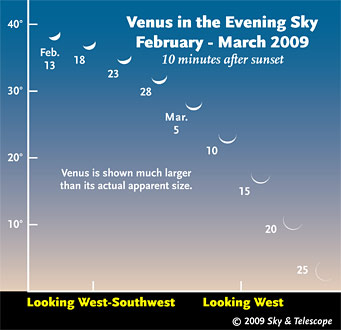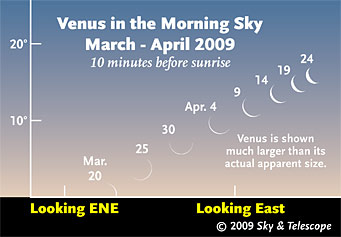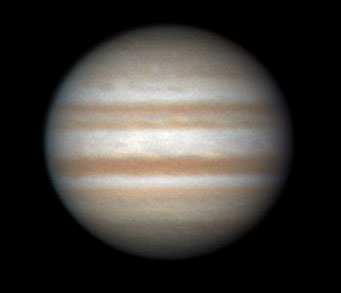Some daily events in the changing sky for March 20 – 28.
Comet Lulin continues fading this week; it's about 7th magnitude. But at least it's high in the evening sky (in central Gemini) and free of moonlight until about March 29th. And its tail is double again! See our article and finder chart.
Friday, March 20
And no, eggs do not balance on end any more easily than at any other time of year (try it). Why should they? When will this goofy urban legend finally die?
Saturday, March 21

Daylight saving time makes it easier to get up in time to see dawn sky sights. On Sunday morning March 22nd, Jupiter shines left of the waning Moon. Although they look close together, Jupiter is actually 2,200 times farther away just now. And it's 40 times bigger!
These scenes are always drawn for the middle of North America (to be exact, latitude 40° north, longitude 90° west). European observers: Move each Moon symbol a quarter of the way toward the one for the previous date. In the Far East, move it halfway. The visibility of objects through bright twilight is exaggerated.
Alan MacRobert
Sunday, March 22
Monday, March 23
Tuesday, March 24
Wednesday, March 25
Thursday, March 26
Friday, March 27
Saturday, March 28
Want to become a better amateur astronomer? Learn your way around the constellations. They're the key to locating everything fainter and deeper to hunt with binoculars or a telescope. For an easy-to-use constellation guide covering the whole evening sky, use the big monthly map in each issue of Sky & Telescope, the essential magazine of astronomy. Or download our free Getting Started in Astronomy booklet (which only has bimonthly maps).

The Pocket Sky Atlas plots 30,796 stars to magnitude 7.6 — which may sound like a lot, but that's less than one star in an entire telescopic field of view, on average. By comparison, Sky Atlas 2000.0 plots 81,000 stars to magnitude 8.5, typically one or two stars per telescopic field. Both atlases include many hundreds of deep-sky targets — galaxies, star clusters, and nebulae — among the stars.
Sky & Telescope
Once you get a telescope, to put it to good use you'll need a detailed, large-scale sky atlas (set of charts; the standards are Sky Atlas 2000.0 or the smaller Pocket Sky Atlas) and good deep-sky guidebooks (such as Sky Atlas 2000.0 Companion by Strong and Sinnott, the even more detailed Night Sky Observer's Guide by Kepple and Sanner, or the classic Burnham's Celestial Handbook). Read how to use them effectively.
Can a computerized telescope take their place? As Terence Dickinson and Alan Dyer say in their Backyard Astronomer's Guide, "A full appreciation of the universe cannot come without developing the skills to find things in the sky and understanding how the sky works. This knowledge comes only by spending time under the stars with star maps in hand and a curious mind." Without these, they note, "the sky never becomes a friendly place."
More beginners' tips: "How to Start Right in Astronomy".
This Week's Planet Roundup
Mercury is hidden in the glare of the Sun.

S&T Illustration
Venus (magnitude –4.2) plunges down out of twilight view in the west by about March 23rd, as it swings toward inferior conjunction between Earth and Sun on March 27th.
But this is an exciting time for Venus viewers! In a telescope Venus is a hairline crescent nearly an arcminute in diameter. And at this conjunction, Venus passes a full 8° north of the Sun. This means it should be visible at both dusk and dawn for at least three days centered on March 23rd as seen from latitude 40° north. The farther north you are, the longer the period of dawn-and-dusk visibility will be.

Even before it quite leaves the sunset sky, the thin crescent of Venus begins emerging before sunrise — for viewers in northern latitudes. These diagrams are drawn for 40° north.
S&T Illustration
We've had reports of people with very sharp vision resolving the thin crescent of Venus with the naked eye. If you want to try, look right around sunset in a bright sky before the planet's glare becomes a problem and it also gets too low. To reduce the effects of your eye's optical aberrations, try looking through a small, round hole 1 or 2 mm wide in a piece of aluminum foil or cardboard. Of course, this also reduces your eye's aperture and theoretical resolving power, so experiment with different-sized holes. Send me your results! Email amacrobert(AT) skyandtelescope(DOT)com, and put Venus Crescent in the subject line.
Telescopically, Venus is best seen in the afternoon daylight; it's less glary against a bright sky, and it's higher in steadier air. Just don't let your telescope accidentally point at the Sun and blind you! Safest is to observe in the shadow of a building located to your west.
For more on Venus's especially favorable conjunction phenomena this year, see our article "Venus at Its 8-Year Best".
Mars (magnitude +1.2) is very low in the sunrise glow. Using binoculars, look for it just above the east-southeast horizon, well to the lower left of much brighter Jupiter, about 30 minutes before sunrise. Good luck.
Ceres, the largest asteroid, is magnitude 7.3 above the back of Leo. Spot it with binoculars using the article and finder chart in the March Sky & Telescope, page 60, or online.

It's starting to be Jupiter season again — if you get up before dawn and have a good view low to the southeast. About this picture, Christopher Go in the Philippines writes: "I have an early start this year. Jupiter was only around 20° above the horizon when I imaged this morning. Seeing was good for this altitude.
"Jupiter seems to have quieted down. Oval BA ["Red Spot Junior"] is visible [indistinctly] on the upper left. But its color is a paler than last year. Will it turn white this year? Who knows. . . .
South is up. "The [double] South Equatorial Belt and the North Equatorial Belt are the same dark red color. The mid-SEB section is very busy. The Equatorial Zone looks quiet with little festoon activity. The NEB is also devoid of activity. It is just dark red. The North Temperate Belt is distinct. The polar regions are dark."
Christopher Go
Jupiter (magnitude –2.0, in Capricornus this year) is getting a little higher in the dawn each week. Look for it low in the east-southeast about an hour before sunrise. The best telescopic views will come early in during morning twilight.
Saturn (magnitude +0.5, near the hind foot of Leo) glows in the east at dusk, well up in the southeast by midevening, and highest in the south around 11 or midnight daylight saving time. Don't confuse Saturn with slightly fainter Regulus 18° (nearly two fist-widths at arm's length) to its upper right in early evening, and more directly to Saturn's right late at night.
Saturn's rings are 3½° from edge on. The rings will open to 4° by late May, then will close to exactly edge-on next September 4th — when, unfortunately, Saturn will be out of sight practically in conjunction with the Sun.
P.S.: Remember the quadruple transit of Saturnian moons across the planet's face that made news on February 24th? Hubble was looking, and last week the Hubble Heritage Project released the images. Wow. These are not science-fiction space art, these are photographs.
Here's a timetable (in Universal Time) of all of transits by big Titan and/or its shadow for the rest of 2009.
Uranus is hidden behind the glare of the Sun.
Neptune is hidden in the glow of sunrise, far in the background of Jupiter.
Pluto (in northwestern Sagittarius) is in the southeast before dawn.
All descriptions that relate to your horizon or zenith — including the words up, down, right, and left — are written for the world's mid-northern latitudes. Descriptions that also depend on longitude (mainly Moon positions) are for North America. Eastern Daylight Time (EDT) equals Universal Time (known as UT, UTC, or GMT) minus 4 hours.
To be sure to get the current Sky at a Glance, bookmark this URL:
http://SkyandTelescope.com/observing/ataglance?1=1
If pictures fail to load, refresh the page. If they still fail to load, change the 1 at the end of the URL to any other character and try again.
 0
0
Comments
You must be logged in to post a comment.